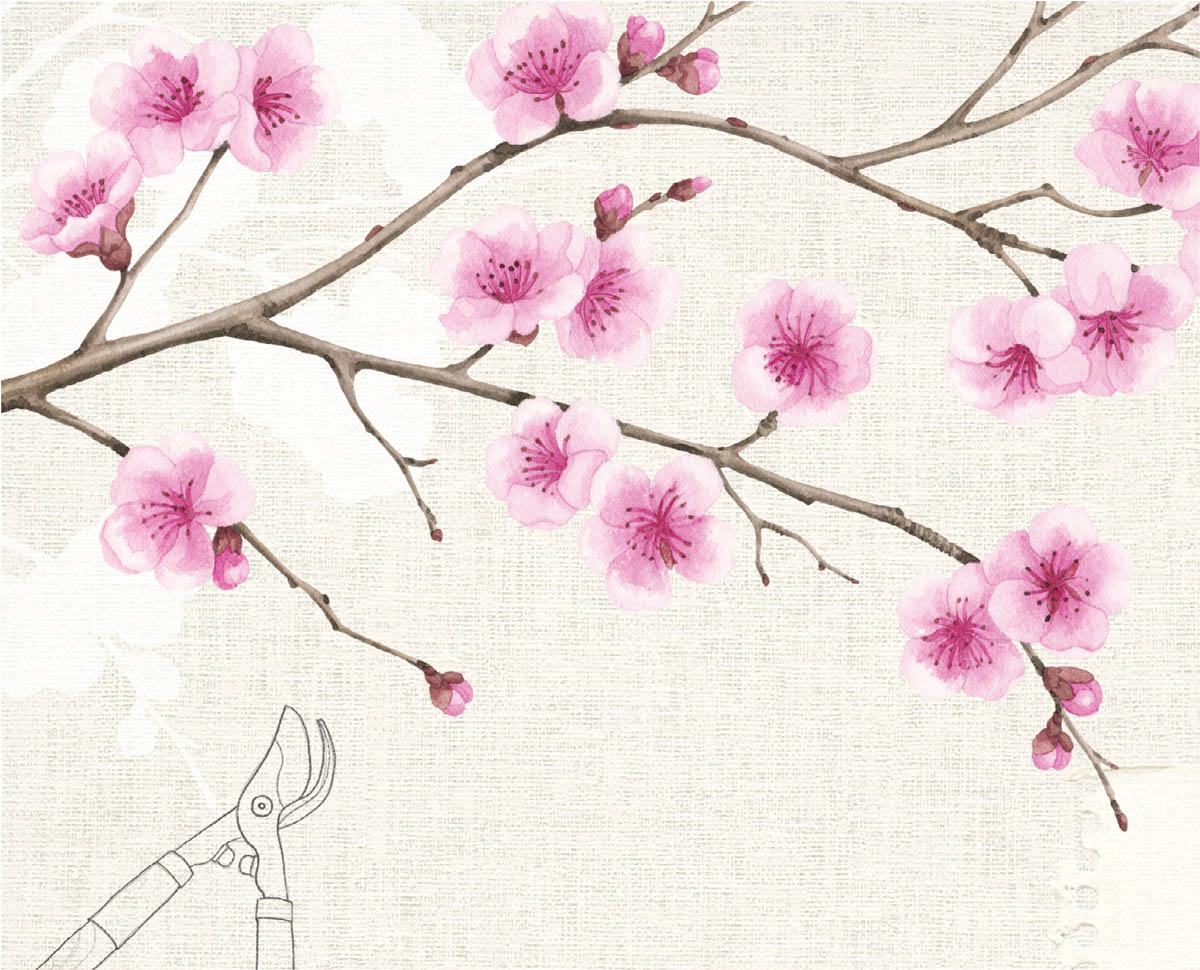

“Can we talk?”
— Joan Rivers
The path to a little fruit tree begins at bareroot planting time with a dramatic heading cut that can only be called aggressive. The opportunity to make this pruning cut is an important reason to buy a bareroot tree. A bareroot whip is young enough and slight enough to take the hard prune that a more established tree won’t manage nearly as well. While they look impressive in comparison, older trees in the nursery were probably left unpruned or, if they were pruned, pruned too high on the trunk.
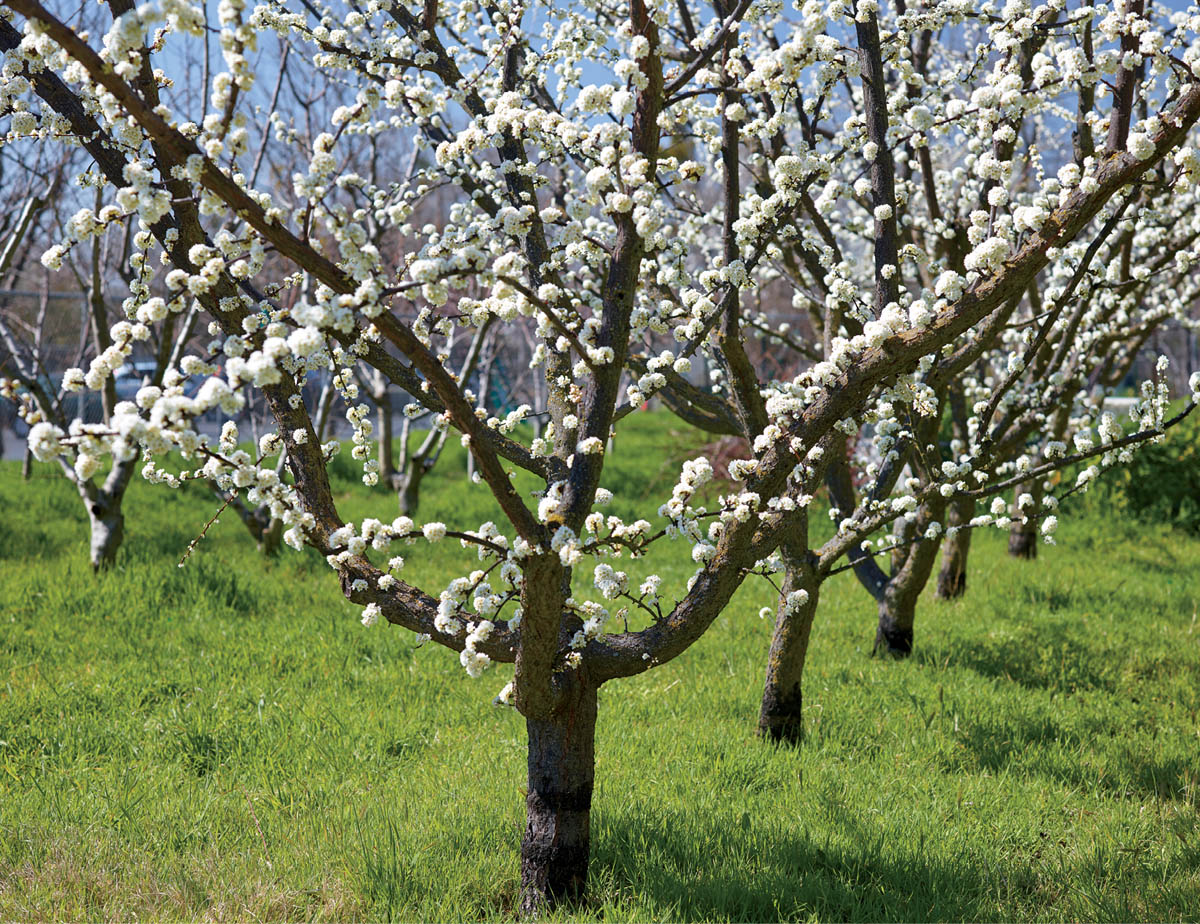
Orchard trees branch uniformly from a hard scaffold prune made when they were saplings.
Whether your tree is a slender, branchless sapling or the most beautifully branched specimen you could find in the bareroot bin, most fruit trees require a hard heading when first planted. By far, this is the most difficult and important pruning decision you ever have to make, but it almost guarantees fruit tree success, whether you want to keep your tree at six feet or let it grow taller. Your planting job is only complete when you’ve lopped off the top two-thirds of your new tree.
This pruning cut is critical, not just for size control and aesthetics but for the ultimate fruit-supporting structure of the tree — the supporting branches called scaffold limbs that develop from the buds below this cut. This heading cut is especially necessary if the tree is to be kept small, but even orchard trees are pruned this way. Orchard trees branch uniformly eighteen to twenty-four inches from the ground because they were pruned. If you take a close look at an orchard, you’ll see that this is true. Carol and Doug Dillon from Hughson, California, planted their new almond orchard in 2004. Once the saplings were in place, Doug went through the newly planted orchard and cut each of the 850 trees to two feet tall. Three years later they were four feet over his head.
Even so, the prune is a hard sell. It evokes a natural and paralyzing resistance. It’s a lot to ask, especially of novice fruit tree growers who lack experience with pruning. This prune makes nursery managers so agitated most can’t bring themselves to do it, even when they know it’s in the best interest of both their customers and the future of the fruit trees that leave the nursery. Many nursery workers with good intentions and years of experience hate taking this on. Even experienced pruners and certified arborists balk at the notion of removing more than half of a just-planted fruit tree.
Steel yourself, get out your loppers, and proceed.
Seriously, though, if you can’t bring yourself to make this cut, you may as well abandon your dreams of a fruit tree, pack away your pruning shears, and take up another avocation that won’t make such tough demands on your constitution. Take this partly on faith and partly on the explanation to follow, but steel yourself, get out your loppers, and proceed. Everything you do with fruit trees past this point will be gravy. I often encouraged our customers to make this first cut themselves while they were in the nursery, knowing that if they could take this one fundamental responsibility, they would never be as fearful about pruning their fruit tree again.
Remember, a heading cut removes the growing tip and awakens the buds below. In its absence, these buds grow into new limbs, each with a growing tip of its own. This heading cut is no exception. The prune is made in winter during the dormant season. It takes advantage of stored nutrients, and the vigorous growth and branching that occur in spring when the plant’s energy is directed to these remaining buds — the perfect combination of conditions to get a just-planted tree off to a strong start.
This hard-line pruning cut accomplishes four important things:
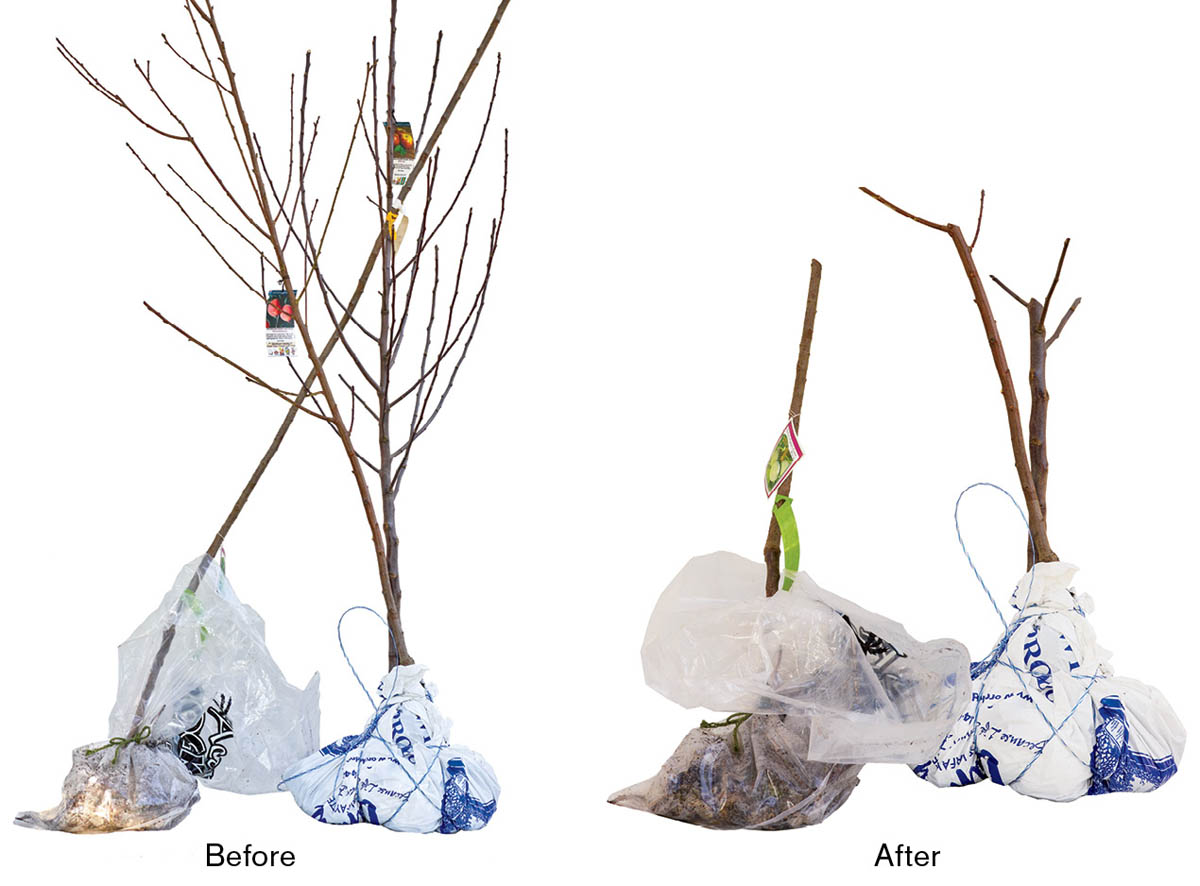
A workable fruit tree begins with a radical prune that removes the top two-thirds of the young whip.
A perfectly branched bareroot specimen in the nursery tempts a fruit tree planter to avoid the initial prune and let the tree grow naturally. To put it in the plainest possible terms: this is a mistake. Like children or puppies, fruit trees absolutely require structure, training, and shaping. If you let it go, your innocent little tree soon becomes a thicketing monster, prone to breakage, fruiting erratically beyond your reach, then dropping that fruit to putrefy on the ground, even if you bought a semidwarf to avoid just these consequences.
If an initial hard pruning cut is the right advice, you might ask, shouldn’t fruit trees come pruned this way already? In the best interest of backyard fruit growers, yes. Fruit trees should probably come with an initial prune, much the way roses are pruned for winter sale, but wholesalers, retailers, and other purveyors of fruit trees aren’t likely to make this cut for you.
Why not? For one thing, it’s hard to sell a fruit tree that’s an eighteen-inch stub. We’re not used to seeing fruit trees this way. Many fruit tree sellers don’t know what fruit trees require, and for others it’s just plain hard to do. Until you personally experience the results of this prune, it intimidates everybody, even professionals, and often especially professionals.
I liked to sell the uncut trees because they gave me the opportunity to talk to each and every customer about my favorite subject. With an uncut tree, the customer chooses the height of the scaffold. Knee-high is about right. There are reasons for slightly higher scaffolds and slightly lower ones. People with different plans and situations deserve options.
Buy a skinny bareroot tree. Make a knee-high cut in winter as soon as possible either in the nursery before you put it in the car, or as you plant it using the directions in the previous section. The resulting low-branching, open-center tree will grow to be shorter, stronger, easier to care for, and far more usefully fruitful.
If you make the cut at the nursery, your new fruit tree fits neatly into the car and you might get help from a trained professional (not that you need it). If you plant the sapling and then make the cut, your knee provides a handy yardstick. In other words, what matters is that you make this cut in a timely fashion, when the tree is fresh from the bareroot bin and still dormant, not where you happen to do it.
Prune a thumb-size whip so it stands — or will stand once it’s in the ground — knee-high or no taller than twenty-four inches. Granted, this sounds harsh and contrary to common sense. Do it anyway. The sapling is young and dormant.
You won’t have a better opportunity. The best structure for the tree-to-come develops as a consequence of this pruning cut. A young tree will probably be a five- to six-foot whip at the nursery. In most cases, if you make the cut properly, you remove more than you leave behind.
The buds on the young trunk look a little like the eyes of a potato. They spiral around the sapling. The place where you make the cut becomes the crotch of the tree once it has established. The trunk will not grow taller. The lower the crotch, the easier it is to keep the tree small. A knee-high prune is reasonable for almost all fruit trees, even if, for some crazy reason, you want to let your tree grow to fifteen feet tall.
Make a clean cut that angles at about forty-five degrees with the bud you’ve chosen to be the top bud. Make the cut close enough to the bud so the cut can heal cleanly in a natural line, but not so close you cut into the bud itself. Several buds should remain below the cut and above the graft, the knobby place on the trunk where the rootstock meets the scion, the variety of the tree you’ve chosen to grow. (See here.) Your beautiful sapling will now be a knee-high stick. Fed from dormant season resources stored in the roots, an open starter scaffold will form by summer.
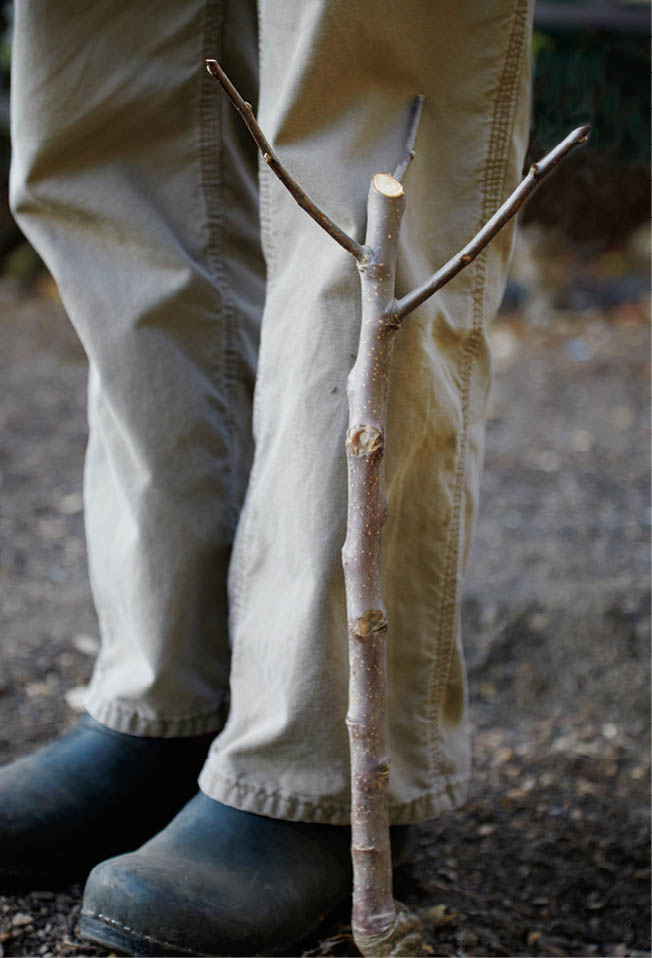
A nicely branched sapling encourages fruit tree planters to avoid the hard scaffold prune. This is a mistake.
Taller prunes can be made lower the first season. People who cut their trees higher, say at three feet, often report back with the wish for a shorter tree and a lower scaffold once they take in how alarmingly fast the trees have grown. This situation is easily remedied in the spring of the first season. By the second year, it’s a different story.
Once the first-year buds start sprouting, simply prune lower to a place where the configuration of leafing buds suits you. The earlier in the season you make this second cut, the more vigorously the new limbs will grow. (See here.) In some instances, it’s appropriate to make the first cut higher, with an intention to make a correction as soon as buds begin to develop. A plant with a stem thicker than three-quarters of an inch may have a harder time pushing buds, for example. Cut it a bit higher, where the caliper is thinner, and then, when branches sprout, take it down to sprouted buds lower on the trunk. Peaches and nectarines sprout more reliably if you cut above a nurse limb, a branch left below a scaffold prune to encourage sprouting. Once the lower sprouts get going, you can take the scaffold as low as you choose.
In any case, planting a bareroot sapling gives you the best opportunity you’ll ever have to build a well-structured fruit tree. Don’t talk yourself out of it. Don’t wait. Next year will be too late. Because this pruning cut is so important and so psychologically discordant, at Scenic Nursery and Berkeley Horticultural Nursery we liked to leave trees uncut in the bareroot bin until we could explain the logic of the prune, and then prune the fruit trees for our customers before they left the nursery. This practice is rare.

A nurse limb encourages sometimes balky peaches and nectarines to sprout.
Almost all deciduous fruit trees take the hard prune, and most require it to be strong and productive. Citrus is an evergreen shrub and won’t need this kind of pruning. A few other exceptions follow.
If allowed to grow tall, persimmons become elegant landscape trees with brilliant fall foliage and a bright display of orange fruit that hangs in the bare tree well into winter. The decision to prune depends on your intentions. Persimmon trees can be pruned to a low, open center and kept short if you want them primarily for fruit or if you’d like a small ornamental tree for the garden. If you want them taller, persimmons develop a lovely open shape when you make some sort of a scaffold prune, either low or higher, but the prune isn’t necessary.
A pomegranate grows more like a large, thicketing, arching shrub than a tree. It is beautiful in the landscape with attractive flowers and fruit. The plant stays naturally at about eight feet. The best approach preserves the integrity of the arching quality of the plant and provides the thickets with space between one another. Remove upright growth at the base to keep a pomegranate airy and in bounds.
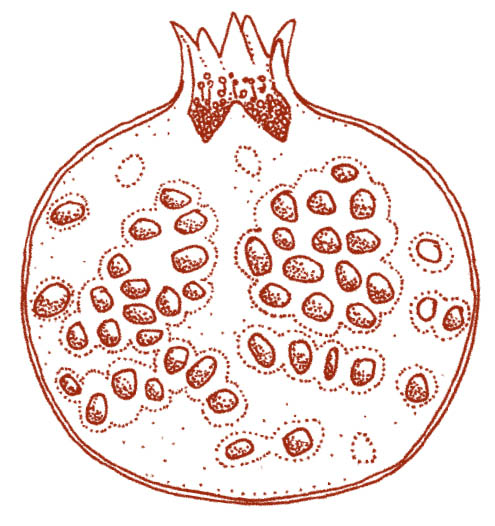
Weeping Santa Rosa plums are also attractive landscape trees that stay naturally small. The fruit of a Weeping Santa Rosa ranks higher than regular Santa Rosa fruit in taste tests, but I haven’t made the comparison myself. If unpruned, the plant grows to be an eight-foot haystack. To prune, stand beneath the canopy in winter or summer and create space between the branches with thinning. A low or higher scaffold prune gives the tree some shape. Branches weep from the scaffold limbs that develop. Weeping Santa Rosas make excellent espaliers. A customer once returned a Weeping Santa Rosa with a thick caliper that had sprouted from only two opposite buds. We replaced it with another and potted up the offending tree. By the following spring, it evolved into a willowy cascade of blooming foliage that we were able to sell for a premium price.
In the case of multiple-graft trees (the three-in-ones and four-in-ones), wait until summer and prune the tips of branches back to keep trees from getting too tall. Because of the way these trees are grafted, a knee-high prune leaves you with nothing but rootstock. See chapter 2 if you want to train an espalier. Leave just-planted, grafted espaliers unpruned at first. They grow straight up from the tips and along their horizontal branches. Prune this upright growth in summer.
If you didn’t make the scaffold prune when you first bought your bareroot tree, you lose the inherent advantages of youthful recovery and the strong response from the winter cut. You can take corrective measures through the first growing season and sometimes even later. Bear in mind, though, that corrections are just that, making the best of a less-than-ideal situation. Large cuts on older wood heal more slowly. The resulting form will never be quite as satisfactory as it could have been.
You didn’t know about the hard scaffold cut and you planted a bareroot sapling without it. In this case, during the first summer around the time of the solstice, cut out the central leader (the vertical trunk or spine of the tree) just above the best set of naturally occurring scaffold branches, even though it’s summer. The “best” branches are placed more or less evenly around the trunk. If your sapling has branches like this occurring at or below knee-high, great. If the branches are higher, the higher scaffold makes it harder to keep the tree small, but a prune this first summer still results in a stronger tree. This prune redirects a tree’s growing energy to the limbs that remain. The scaffold won’t develop in summer with the vigor of the winter prune, but it’s better than not pruning at all. If you miss the solstice, this prune can also be made the first winter, but rarely later than that.
If you didn’t make the cut the first season or if you cut the scaffold too high, consider the possibility of a do-over the following January. Winter pruning results in vigorous growth. Take advantage. I decided to take down a too-tall pluot scaffold the following winter. I cut off the scaffold that had formed the year before. This left the plant knee-high and without branches. The trunk was an inch and a quarter thick, too developed by the second year to break new buds very well, but a strong root system had established itself and stored enough energy to give the tree a good push. This second prune delayed fruit production a year. The tree is somewhat one-sided. It lacks the grace it would have had with the original scaffold, but it’s a tree I can manage. With a do-over, the smaller the caliper, the more easily the tree takes the lower cut and the better your chances for a balanced scaffold. If the tree is unpruned at a year or two, you can sometimes prune out the central leader above lower branches to create a more open, sunlight-friendly form.
You have a tree on your hands that’s much too big. You wish it were smaller. Sooner or later in every workshop someone always asks: Can I make my big tree small? The answer to this all too common and tragic question is, most likely, no. By the time a tree is established, all you can do is damage control. While full-grown trees can be made smaller (my exasperated neighbor took the chain saw to his twenty-five-foot apple tree), it’s one thing to train a tree to be small from the outset and quite another to rein one in.
If you have an oversized tree, the rule of thumb is to take it down a third at a time, each third evenly distributed throughout the canopy, over a period of three years. This probably isn’t a do-it-yourself project. Call a certified arborist with fruit tree experience. My neighbor is a former logger who follows his own rules. He sawed off the entire canopy of the tree in January. The tree recovered more gracefully than I expected. It still branches at about five feet and won’t produce fruit for three or four years.
Consider certain aspects of the tree in question before embarking on either course of action. For instance, will the resulting tree be small enough? From a practical standpoint, a twelve-foot tree isn’t much smaller than a fifteen-footer. You still need a ladder. Bear in mind, too, how your newly reduced tree will look in the garden. Radical pruning can destroy a tree’s form. Do you want to preserve the tree because the fruit is rare or especially flavorful? Is the tree aged? If the tree is old—twenty years for stone fruits and, in mild climates, forty to fifty years for an apple or pear—a more reasonable decision might be a plan to eventually remove the tree and begin again with something you can train to be much smaller.
Even if the tree isn’t old and you just want something smaller, it often makes sense to get a new tree going and remove the too-big tree when the young one starts fruiting. Fruit from a new Burgundy plum that you prune to keep small from the start will taste the same as fruit from a Burgundy plum that has outgrown your garden space and your energy level. The new tree takes only three or four years to bear. On rare occasions, a tree has sentimental value that trumps practical considerations. If this is the case, call an arborist.
Most people have an understandable reverence for trees and are loathe to remove them, but trees are not created equal, especially in limited garden space. You can spend a lot of money and effort trying to save or alter poor performers, be they misplaced, overgrown, or abundant producers of marginal fruit. Sometimes, tree removal is the best option. Plant a new tree that better suits you.
Alison McKee, my colleague at Berkeley Horticultural Nursery, grew up on a sheep farm in Maine, with apple trees on her family’s property and pick-your-own orchards all around. She knew what a good apple tasted like and objected to the apples she encountered in California. In her West Coast exile, her parents shipped apples from home. She longed for two things: independence from renting property and fresh-picked fruit. With that in mind, she bought a small bungalow in Richmond, California, with a tattered but promising backyard. The house needed a new foundation, a detail that could be worked out in time.
Meanwhile, Alison had food to grow and fruit trees to plant.
The benefits of reduced fruit production made sense to Alison. Timed harvests for fresh fruit most of the year and maximizing space with small trees and close planting appealed to her. What better reason to live in California? Her backyard wasn’t huge, twenty feet wide and forty feet deep, but she had sun all day. The concrete patio and a shabby lawn went first. She hacked out old and overgrown shrubbery. She granted dispensation only to an existing Brown Turkey fig.
Alison planted a bareroot Santa Rosa plum the first winter. She had solid nursery experience and horticulture training from Merritt College in Oakland. Bright, interested, and a competent pruner, she knew her way around plants. She had enough experience to think that while the idea of a knee-high prune for her new plum tree might have merit, she felt it was, as she put it, “unnecessarily rash.”
Perhaps the cut had value. I insisted it did. She compromised with a waist-high prune when her bareroot whip first went in the ground. Her Santa Rosa grew energetically, as plums will. The tree was over her head that first season and got completely away from her in year two, growing to ten feet tall and commandeering her precious garden space with height, width, and shade. By year three, she had had enough. She took the tree down and started over.
Ten years have passed. Alison harvests figs, persimmons, and oranges from her small backyard garden. She grows a plum and a pluot planted eighteen inches apart and pruned away from one another, as if they were a single tree. She grows two pears, a Bartlett and a 20th Century Asian pear, and keeps all these trees only a little taller than she is. After the plum debacle, she cut each new bareroot tree at only six inches above the graft. Up against the fence, a Gala apple stands five feet tall and easily produces a hundred apples, as satisfying as the apples from Maine, in part, at least, because she grows them herself.
Alison lost an apricot tree to water-logged soil one rainy winter. She just planted another. She took out a nectarine because the fruit didn’t get enough heat in Richmond to ripen well but considers her other experience with small trees “entirely positive.” The trees are “no trouble at all,” she says. They’re fun to prune. She does little in the way of dormant spray or insect control. The fruit is easy to harvest. She shares her harvest with friends and birds. She says that there’s nothing to it and loves having taken fruitful advantage of such a tiny space.